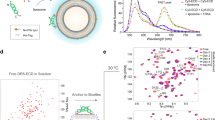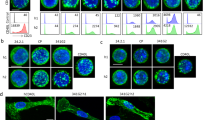Abstract
TNF-related apoptosis-inducing ligand (TRAIL) is a typical member of the tumor necrosis factor (TNF) ligand family that is expressed as a type II membrane protein (memTRAIL) and signals apoptosis via the death domain-containing receptors TRAIL-R1 and -2. Soluble recombinant derivatives of TRAIL (sTRAIL) are considered as novel tumors therapeutics because of their selective apoptosis inducing activity in a variety of human tumors but not in normal cells. Using antagonistic antigen-binding fragment (Fab) preparations of TRAIL-R1- and TRAIL-R2-specific antibodies, we demonstrate in this study that TRAIL-R1 becomes activated by both the soluble and the membrane-bound form of the ligand, whereas TRAIL-R2 becomes only activated by memTRAIL or soluble TRAIL secondarily cross-linked by antibodies. Furthermore, we show that the restricted signal capacity of sTRAIL can be readily converted into a fully signal competent memTRAIL-like molecule, i.e. a TRAIL-R2 stimulating ligand, by genetic fusion to an antibody derivative that allows antigen-dependent ‘immobilization’ of the fusion protein to cell surfaces. We conclude that antibody targeting-dependent activation can be used to design selective therapeutics derived of those ligands of the TNF family that are biologically inactive in their soluble form.
This is a preview of subscription content, access via your institution
Access options
Subscribe to this journal
Receive 50 print issues and online access
$259.00 per year
only $5.18 per issue
Buy this article
- Purchase on Springer Link
- Instant access to full article PDF
Prices may be subject to local taxes which are calculated during checkout



Similar content being viewed by others
References
Ashkenazi A, Pai RC, Fong S, Leung S, Lawrence DA, Marsters SA, Blackie C, Chang L, McMurtrey AE, Hebert A, DeForge L, Koumenis IL, Lewis D, Harris L, Bussiere J, Koeppen H, Shahrokh Zan, Schwall RH . 1999 J. Clin. Invest. 104: 155–162
Fanger NA, Maliszewski CR, Schooley K, Griffith TS . 1999 J. Exp. Med. 190: 1155–1164
Garin-Chesa PL, Old L, Rettig WJ . 1990 Proc. Natl. Acad. Sci. USA 87: 7235–7239
Griffith TS, Wiley SR, Kubin MZ, Sedger LM, Maliszewski CR, Fanger NA . 1999 J. Exp. Med. 189: 1343–1354
Jo M, Kim TH, Seol DW, Esplen JE, Dorko K, Billiar TR, Strom SC . 2000 Nat. Med. 6: 564–567
Kayagaki N, Yamaguchi N, Nakayama M, Eto H, Okumura K, Yagita H . 1999 J. Exp. Med. 189: 1451–1460
Mariani SM, Krammer PH . 1998a Eur. J. Immunol. 28: 973–982
Mariani SM, Krammer PH . 1998b Eur. J. Immunol. 28: 1492–1498
Mühlenbeck F, Schneider P, Bodmer JL, Schwenzer R, Hausser A, Schubert G, Scheurich P, Moosmayer D, Tschopp J, Wajant H . 2000 J. Biol. Chem. 275: 32208–32213
Nitsch R, Bechmann I, Deisz RA, Haas D, Lehmann TN, Wendling U, Zipp F . 2000 Lancet 356: 827–828
Rippmann JF, Pfizenmaier K, Mattes R, Rettig WJ, Moosmayer D . 2000 Biochem. J. 349: 805–812
Schneider P, Holler N, Bodmer JL, Hahne M, Frei K, Fontana A, Tschopp J . 1997 J. Exp. Med. 187: 1205–1213
Schneider P, Tschopp J . 2000 Pharm. Acta. Helv. 74: 281–286
Walczak H, Miller RE, Ariail K, Gliniak B, Griffith TS, Kubin M, Chin W, Jones J, Woodward A, Le T, Smith C, Smolak P, Goodwin RG, Rauch CT, Schuh JC, Lynch DH . 1999 Nat. Med. 5: 157–163
Walczak H, Krammer PH . 2000 Exp. Cell Res. 256: 58–66
Acknowledgements
We thank P Schneider and J Tschopp (University of Lausanne, Switzerland) for kindly providing Flag-tagged TRAIL and TRAIL-R1/2-Fc. We further thank WJ Rettig and J Park (Boehringer Ingelheim Pharma KG, Germany) for supply with cF19 and HT1080-Fap. We thank H Yagita (Juntendo University School of Medicine, Japan) and A Ashkenazi (Genentech Inc., USA) for anti-TRAIL mAbs RIK-2 and 2G9 and 2E11, respectively.
Author information
Authors and Affiliations
Corresponding author
Rights and permissions
About this article
Cite this article
Wajant, H., Moosmayer, D., Wüest, T. et al. Differential activation of TRAIL-R1 and -2 by soluble and membrane TRAIL allows selective surface antigen-directed activation of TRAIL-R2 by a soluble TRAIL derivative. Oncogene 20, 4101–4106 (2001). https://doi.org/10.1038/sj.onc.1204558
Received:
Revised:
Accepted:
Published:
Issue Date:
DOI: https://doi.org/10.1038/sj.onc.1204558
Keywords
This article is cited by
-
Regulation of anoikis by extrinsic death receptor pathways
Cell Communication and Signaling (2023)
-
NCTR25 fusion facilitates the formation of TRAIL polymers that selectively activate TRAIL receptors with higher potency and efficacy than TRAIL
Cancer Chemotherapy and Pharmacology (2021)
-
Synergies in exosomes and autophagy pathways for cellular homeostasis and metastasis of tumor cells
Cell & Bioscience (2020)
-
Tumor-derived extracellular vesicles: insights into bystander effects of exosomes after irradiation
Lasers in Medical Science (2020)
-
Tumor-derived extracellular vesicles: reliable tools for Cancer diagnosis and clinical applications
Cell Communication and Signaling (2019)



